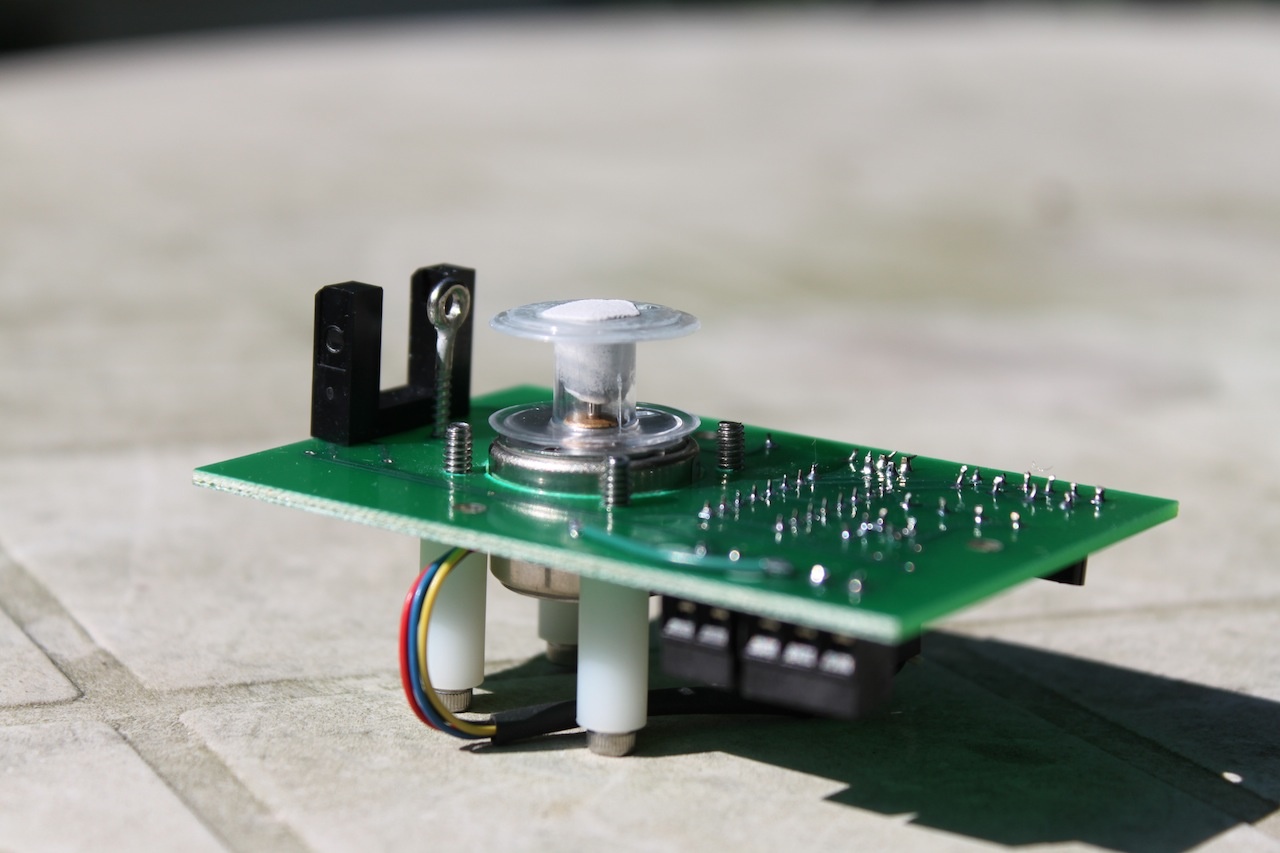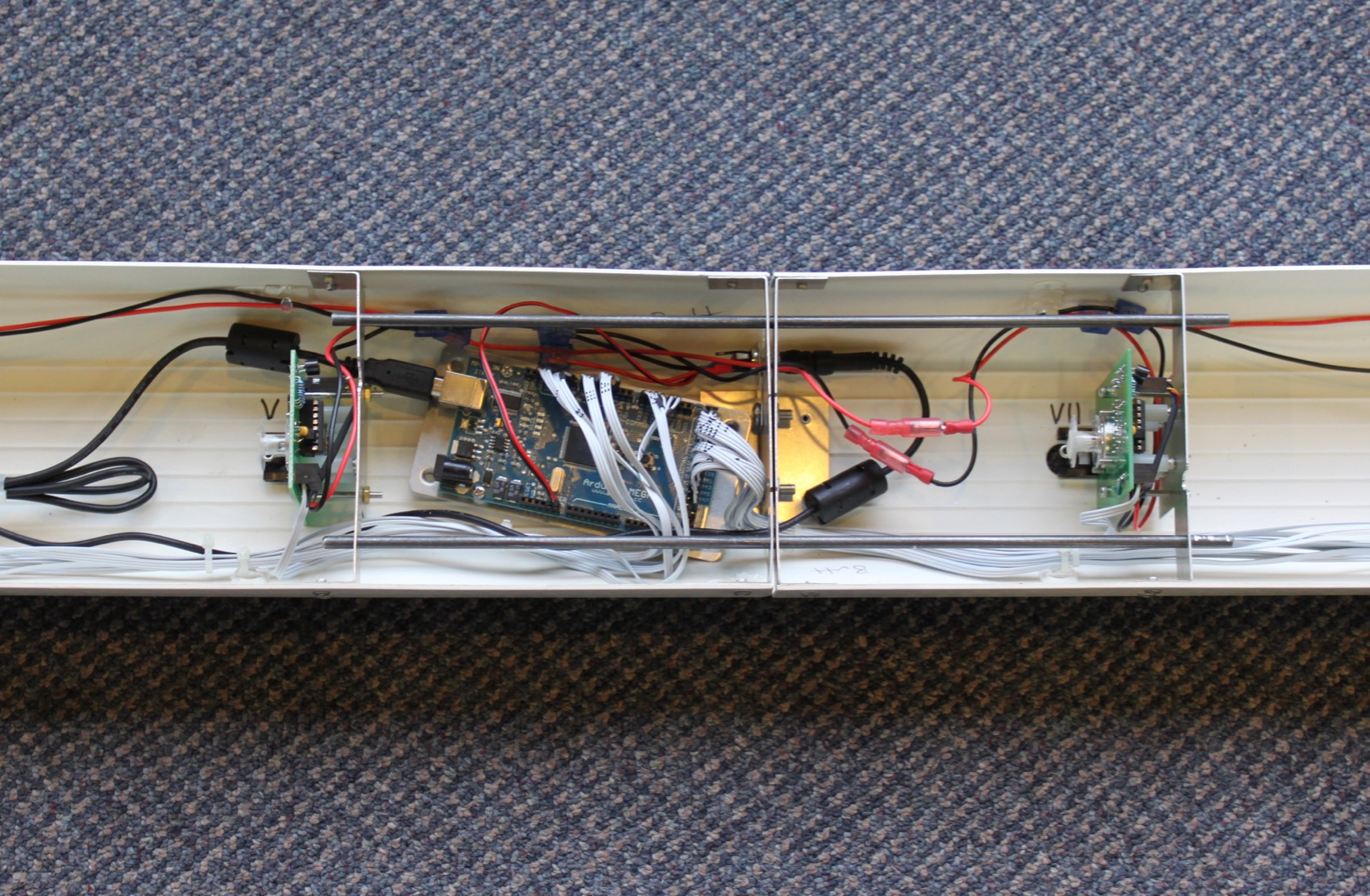Taxatron is a large, kinetic sculpture installation that I built from scratch in 2010, which displays large graphs of scientific data with a 24 foot long piece of purple silk chiffon. The idea was to try to display scientific data in a very “unscientific” way, and lots and lots of sheer purple silk were about as unsciency as I could think of. When was the last time you had a cocktail underneath science data? Or had your data blown around by the breeze from an open window? Maybe you can learn something new about biodiversity while also making it billow by fanning it with your hands?
Under the hood of Taxatron is an array of stepper motors with custom circuit boards that I made, all being coordinated by an Arduino Mega to control them all. It took me way out of my comfort zone as a software engineer, involving circuit design, sheet metal fabrication, figuring out how to hang the thing from the ceiling with removable fasteners, and hand sewing an 8-yard long hem in silk.
The purple silk represents a timeline from 1750 to 2000. It displays a histogram of the number of new species discovered per year in any particular grouping of organisms (called “taxa”). In the image above, we can see the number of new species of octopus discovered every year. There are two major spikes in the early Twentieth Century, which correspond to two major published volumes on mollusks. In the video below, we can see the number of new turtles, birds, and rodents discovered per year since Linnaeus first described species in 1750. The silk moves beautifully as it transitions from one species to another.

The chiffon creates an entirely new setting for the scholarly data that Taxatron displays. Taxatron recontextualizes “hard science” data into something soft, translucent, and easily mutable. Taken out of the safety of a hard glass computer screen, or the comfort of a poster session, the data is vulnerable, suspended for viewers to inspect from any angle, and even to be buffeted by a strong wind.
Lately, there has been much ado about “transparency” in regards to data. Taxatron takes this charge literally. Light easily passes through the cloth, allowing viewers to visually interact with each other, and allowing the projected metadata to radiate through the cloth, wholly becoming part of the medium. The material selection also plays a pivotal role in the movement of the graphs, effortlessly transforming from one shape to another, and raising important questions about the permanence or fleetingness of scientific discovery and the organisms that inhabit our planet.

Taxatron was displayed at the TDWG 2010 conference in Woods Hole, and again at TEDxWoodsHole. Receptions at both events allowed scientists and nonscientist alike to view, discuss, and even touch scholarly data. I think my favorite part of the event was hearing the librarians and archivists from the MBLWHOI Library correlate spikes in the histograms with the influential monographs that described those species.

From a technical standpoint, the chiffon is suspended from an array of 15 stepper motors, which are mounted to a housing hung from the ceiling. With the help of an electrical engineer friend, I created custom circuit boards that contain the driver circuit, stepper motor mount, and a photo switch used to calibrate the system. The chiffon is suspended from a strand of thread, attached to a small pulley mounted on the stepper motor. The pulley is actually a sewing machine bobbin, which turned out to be just the right size!
The stepper motors can move the silk into a wide variety of shapes by spooling the thread around a pulley, thus shortening or lengthening the thread suspending each segment of cloth.

Inside the housing, I fabricated mounting brackets from sheet metal to hold the stepper motor boards in place. All the steppers are wired to an Arduino Mega, which runs the show. I wrote firmware in the Arduino to drive the motors given commands from the serial port. Every time the sculpture powers on, it calibrates itself with the photo switches on each motor board; this allows me to use any length of string to suspend the cloth; the firmware will scale the measurements accordingly.

I soldered all the components onto the circuit boards, mounted the motors, fabricated the sheet metal mounting brackets, and wired up everything. . The main housing was 16 feet long, but needed to into my car, so it broke down into two halves that attached with steel rods. I assembled the sculpture on-site, hung it from the ceiling, ran all the wires, and attached the silk to the steppers over the course of a day.

Taxatron hung at TDWG 2010 and TEDxWoodsHole 2010; unfortunately, both events were extremely short, and I was not able to push the limits of what Taxatron can do because of its temporary location. As you can tell, I barely had time to snap a few photos. I am looking for a home for Taxatron that would allow it to hang for an extended period of time, and allow me to fully develop the projection software to transform the cloth into a unique and truly memorable experience.